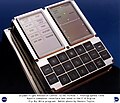Файл:Apollo display and keyboard unit (DSKY) used on F-8 DFBW DVIDS683588.jpg
Перейти до навігації
Перейти до пошуку

Розмір при попередньому перегляді: 765 × 600 пікселів. Інші роздільності: 306 × 240 пікселів | 612 × 480 пікселів | 980 × 768 пікселів | 1280 × 1004 пікселів | 2560 × 2007 пікселів | 3030 × 2376 пікселів.
Повна роздільність (3030 × 2376 пікселів, розмір файлу: 6,18 МБ, MIME-тип: image/jpeg)
Історія файлу
Клацніть на дату/час, щоб переглянути, як тоді виглядав файл.
| Дата/час | Мініатюра | Розмір об'єкта | Користувач | Коментар | |
|---|---|---|---|---|---|
| поточний | 06:29, 9 жовтня 2021 |  | 3030 × 2376 (6,18 МБ) | Huntster | Cropped 9 % vertically using CropTool with lossless mode. |
| 06:28, 9 жовтня 2021 |  | 3030 × 2606 (5,97 МБ) | Huntster | Full resolution from NASA. | |
| 00:42, 6 травня 2015 |  | 1536 × 1321 (303 КБ) | Fæ | == {{int:filedesc}} == {{milim | description = {{en|1=The display and keyboard (DSKY) unit used on the F-8 Digital Fly-By-Wire (DFBW) aircraft during Phase I of the fly-by-wire program. Warning lights are in the upper left section, displays in the uppe... |
Використання файлу
Така сторінка використовує цей файл:
Глобальне використання файлу
Цей файл використовують такі інші вікі:
- Використання в ar.wikipedia.org
- Використання в en.wikipedia.org
- Використання в es.wikipedia.org
- Використання в fi.wikipedia.org
- Використання в fr.wikipedia.org
- Використання в he.wikipedia.org
- Використання в hu.wikipedia.org
- Використання в ja.wikipedia.org
- Використання в pl.wikipedia.org
- Використання в ru.wikipedia.org

